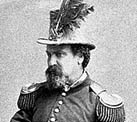
Norton I,
Emperor of the United States
and Protector of Mexico
Home
Random Information
TarnationSerious Talk About Humor in the Office
Surveys: Making Your Opinion Count
Dear Mr. Manufacturer Guy
Angus!
The Polymurphic Object
Sutter's Fort
Dave Barry Gets a Helicopter Lesson
Open Letter to Bill Gates "F*** the Nazis," says Churchill's Parrot
John Sutter and Sutter's Fort
A Painting of Sutter's Fort from 1847 (Click for Larger Image) A Brief Biography |
|||
|
(source: official flyer received at the fort) John A. SutterJohn Sutter was born in 1803 at Kandern, Baden, Germany. Sutter became an apprentice in a book publishing house as a teenager. By the age of 23 he was working as a clerk and had married Annette Dubeld. His first ventures as owner of a dry goods and drapery shop were financial failiures. In 1834, at the age of 31, Sutter sailed to New York, leaving his family behind. Settling in Missouri, Sutter in 1835 and 1836 joined trading caravans headed for Santa Fe. In 1838 he traveled with the American Fur Co. and journeyed to the Hudson's Bay Co. Pacific headquarters at Fort Vancouver. From Canada Sutter sailed to Honolulu and was stranded there for four months waiting for passage back. He then went to Alaska with some native Hawaiians. He sailed south down the coast of California till he put up in the Sacramento River and into the American River, landing at the intersection of today's 28th & C Streets in Sacramento. His laborers promptly built the first buildings of the colony which were grass structures. Sutter considered himself a Swiss. He was skilled in Indian affairs and overly generous to settlers. He was a polished gentleman, one who valued books, and he kept his vision of settling the new frontier uppermost. The FortIn 1840, Sutter built an adobe fort with the aid of his growing work force. The walls of the fort were 2 1/2 feet thick and 15-18 feet high. The compound was 320 feet long. He had quarters for his workers, a bakery, blanket factory, blacksmith shop, carpenter shop, and other workshops within the fort. He also had a tannery on the American River. A maximum of 300 people could have used the fort during daylight hours. Wheat farming, barley, peas, and beans, cotton, fur trading, a successful whiskey and brandy distillery provided Sutter with food and provisions. Sutter's Fort, of course, flew the mexican flag as we do today. Sutter, during the conflict raging between Americans and Mexicans, maintained a friendly relationship with both parties. Sutter's fort is famous as a temporary refuge for pioneers between 1841 and 1849. Sutter provided free shelter and supplies to weary settlers. He also recruited the famous Donner Party. During the winter of 1846-1847, eight-nine of the party were trapped in high snows at Donner Pass in the Sierra Nevada Mountains. Sutter sent rescuers who brought back forty-seven survivors. The rest, unfortunately, perished. On January 24, 1848, James W. Marshall was trying to deepen the tailrace of the mill at Sutter's Fort and accidentally discovered gold. Sutter tried to keep the discovery a secret, but the news leaked out and soon thousands seeking gold came to California to search for their fortune. Unscrupulous men began swindling Sutter out of his holdings and squatters took over much of his land. Sutter's debts began piling up so he transferred his holdings to his eldest son, John A. Sutter. The Fort was sold for $7,000 at the end of 1849. Sutter traveled to WAshington D.C, and, along with his wife, tried to obtain reimbursement from Congress for his aid to emigrantsl his help in colonizing the State of California; and his losses from having his Sobrante Land Grant declared invalid by the courts. On June 16th, 1880, Congress adjourned without passing a bill that would have given him $50,000 reimbursement. John Sutter died two days later at the Mades Hotel near the Capitol. His wife was buried beside him six months later. By 1860 all that remained was his house, known today as the Central Building. It was purchased in 1890 and donated to the State in 1891. Reconstruction began in 1891 based on Civil Engineer Grunsky's reconstruction plan. In 1947, Sutter's Fort became a unit of the California State Park System. Sutter's Fort is located in Mid-town Sacramento between K and L Streets and 26th and 28th Streets. From San Francisco on I-80 take Business 80/Hwy 50 east. Take the Business 80 exit to the N Street turn off. Travel straight on 30th St. then turn left under the freeway at L Street to the Fort which will be located on your right. Bring quarters for the parking meters. Parking is free on Sundays. A Few Related LinksCalifornia State Parks Official Web Site

Sutter's Fort and St. Francis Church NOTE: WHEREAS this article is reprinted here without permission, and WHEREAS there is no commercial intent, and WHEREAS We stole it fair and square, and WHEREAS it is here solely for Our personal enjoyment, THEREFORE, We do hereby grant a special dispensation from copyright law. -- Norton I, Emperor of the United States, Protector of Mexico, and prospective consort to the Queen of Great Britain More Fun Stuff: |
The Emperor's
|
||